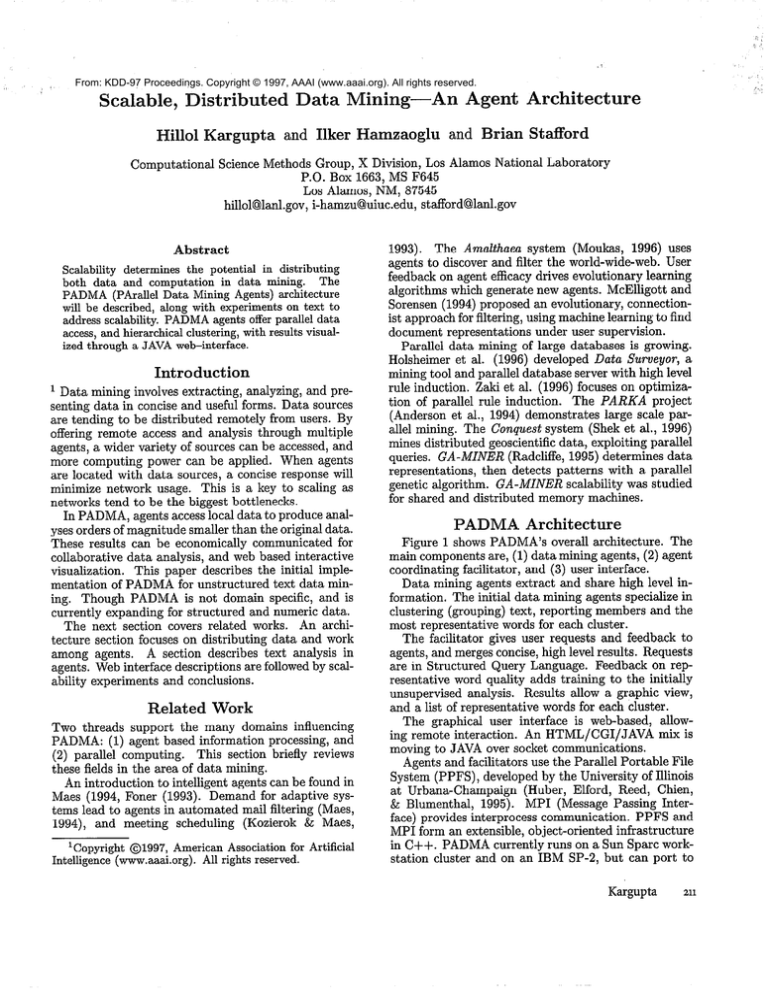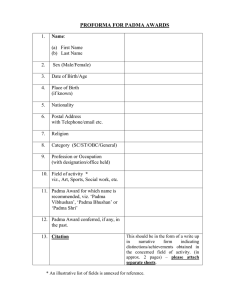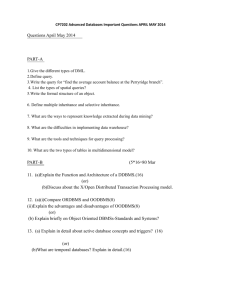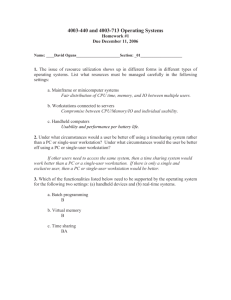
From: KDD-97 Proceedings. Copyright © 1997, AAAI (www.aaai.org). All rights reserved.
Scalable,
Distributed
Hill01 Kargupta
Data Mining-An
and Ilker
Hamzaoglu
Agent
and Brian
Architecture
Stafford
Computational Science Methods Group, X Division, Los Alamos National Laboratory
P.O. Box 1663, MS F645
Los Alamos, NM, 87545
hillol@lanl.gov, i-hamzu@uiuc.edu, stafford@lanl.gov
Abstract
Scalability
h&h
“.,“.I
determines the potential in distributing
anrl
.rlata
. ..Avw-_..a
rnmnrlt,af.inn
“.,--I..v-“e--
in
^-
cln.+n.
mining.
--2-----o.
The
PADMA (PArallel Data Mining Agents) architecture
will be described, along with experiments on text to
addressscalability. PADMA agentsoffer parallel data
access, and hierarchical clustering, with results visualized through
a JAVA web-interface.
Introduction
1 Data mining involves extracting, analyzing, and presenting data in concise and useful forms. Data sources
are tending to be distributed remotely from users. By
offering remote access and analysis through multiple
agents, a wider variety of sources can be accessed,and
more computing power can be applied. When agents
are located with data sources, a concise response will
minimize network usage. This is a key to scaling as
networks tend to be the biggest bottlenecks.
In PADMA, agents accesslocal data to produce analyses orders of magnitude smaller than the original data.
These results can be economically communicated for
collaborative data analysis, and web based interactive
visualization. This paper describes the initial implementation of PADMA for unstructured text data minPAnMA
ia
nnrl
Ill”U~‘L
1 .aLYllllL
IY nnt
&IVY rlnmain
U”~~&LuL-A an&fir
YyuY’*~v,
w--u ia
A”
ing . Thnnmh
currently expanding for structured and numeric data.
The next section covers related works. An architecture section focuses on distributing data and work
among agents. A section describes text analysis in
agents. Web interface descriptions are followed by scalability experiments and conclusions.
Related
Work
Two threads support the many domains influencing
PADMA: (1) agent based information processing, and
131
\“,
naralld
y- w-*u* rnmnnt.inw
uv.--r y”**-o.
This
s&infi
h&$!y
reviews
_.__..-
these fields in the area of data mining.
An introduction to intelligent agents can be found in
Maes (1994, Foner (1993). Demand for adaptive systems lead to agents in automated mail filtering (Maes,
1994), and meeting scheduling (Kozierok & Maes,
‘Copyright
01997, American Association for Artificial
Intelligence (www.aaai.org).
All rights reserved.
1993). The Amalthea system (Moukas, 1996) uses
agents to discover and filter the world-wide-web. User
feedback on agent efficacy drives evolutionary learning
algorithms which generate new agents. McElligott and
Sorensen(1994) proposed an evolutionary, connectionist approach for filtering, using machine learning to find
document representations under user supervision.
Parallel data mining of large databases is growing.
Holsheimer et al. (1996) developed Data Sumreyor, a
mining tool and parallel database server with high level
rule induction. Zaki et al. (1996) focuses on optimization of parallel rule induction. The PARKA project
(Anderson et al., 1994) demonstrates large scale parallel mining. The Conquest system (Shek et al., 1996)
-.-T--.~ ai56riuubeu
.l:+..rL..l-~ geuswaucnlr;
_^^_^:-d.:cc^ ua~a,
-1-L- explu~~lng
-sm-,-:A:-.- _L
-,,,,.,
mine5
p,a~a~la~
queries. GA-MINER (Radcliffe, 1995) determines data
representations, then detects patterns with a parallel
genetic algorithm. GA-MINER scalability was studied
for shared and distributed memory machines.
PADMA
Architecture
Figure 1 shows PADMA’s overall architecture. The
main components are, (1) data mining agents, (2) agent
coordinating facilitator, and (3) user interface.
Data mining agents extract and share high level infnrmat.irm
minincs
A,,..I~-.“” &..&.. The
...--_ init,inl
____“_-_ data
--rd-r---------D
xwntq
-O---A
qnnr.iali7e
L =--- 1_1-
in
___
clustering (grouping) text, reporting members and the
most representative words for each cluster.
The facilitator gives user requests and feedback to
agents, and mergesconcise, high level results. Requests
are in Structured Query Language. Feedback on representative word quality adds training to the initially
unsupervised analysis. Results allow a graphic view,
and a list of representative words for each cluster.
The graphical user interface is web-based, allowing remote interaction. An HTML/CGI/JAVA mix is
moving to JAVA over socket communications.
Agents and facilitators use the Parallel Portabie Fiie
System (PPFS), developed by the University of Illinois
at Urbana-Champaign (Huber, Elford, Reed, Chien,
& Blumenthal, 1995). MPI (Message Passing Interface) provides interprocess communication. PPFS and
MPI form an extensible, object-oriented infrastructure
in C++. PADMA currently runs on a Sun Spare workstation cluster and on an IBM SP-2, but can port to
Kargupta
211
Disk
Disk
l
User Request
*
0
Result
Figure 1: The PADMA architecture.
distributed machines with MPI and Unix file I/O . Parallel access,and analysis by agents is coverednext.
Parallel Data Access
On a large scale, accesstime is a critical limiting factor.
Parallel accessmay help decreaseresponsetimes (Dewitt & Gray, 1992). Also, Inter agent communication
is slower than memory accessand should be limited.
Each agent has its own disk for local operations.
This provides parallel data access.Striped and blocked
algorithms are used to distribute documents among
agents. The agents and the facilitator also maintain file
caches. Cache management, e.g. FIFO replacement,
write-back and prefetching, maximize cachebenefits.
Agents in PADMA also provide paraiiei reiational
database functionality. Each corpus is stored as a relational database table with document number, text,
ngrum vector attributes. A subset of SQL is supported, including creation/deletion of tables and hash
indices, and parallel select and join. PADMA uses
intra-operator parallelism.
SQL queries allow a focus on special conditions. The
NGRAM = ELECTRON condition selects data sets
with the feature NGRAIMinstantiated to ELECTRON.
In a query and analyze (cluster), a table subset is selected and reanalyzed-without creating a new table.
Agents locally select and analyze data, only needing
to communicate concise results to the facilitator. This
scalable parallel select was used in experiments.
There are three major algorithms for table joins (Dewitt, 1991; Schneider, 1989). Nested-join cross com212
KDD-97
pare tables with complexity O(n2). Sort-mergejoin reduces complexity to O(n log n) by sorting both tables
on join attributes, then comparing by binary search.
Hash-join can be fastest, but is ineffective for nonequijoin operations. PADMA uses sort-merge join.
A fragment and replicate strategy parallelizes the
sort-mergejoin. Each agent joins a pair of fragments,
then broadcaststo the other agents. After inter-agent
comparisons,the facilitator merges results.
In PADMA, agents primarily analyze local data and
communicate a small or null “concept graph” to the
facilitator. The facilitator combines concept graphs
and sends results to the user interface. Scalability is
achievedby minimizing communication and is best appreciated in the context of the text analysis modules.
The first type of analysis in PADMA’s data mining
agents is clustering. Clustering groups items based on
similarity. A feature vector is formed to from the values
of features extracted from items in a data base. Similarity is then measuredgeometrically, with closer vectors being more similar. Mathematics has an abstract
definition of ‘measure’,which supports many ways to
measure. For text, Euclidean distance is too sensitive
kp10 f&gre
fn
“., clnnnnmt.
xv”I*.-v--” aiw
“--.-) hnt.
--” t.hp
---- n.ncrle
--‘-b-~ b&yepc
vectors tells if two items have features in similar proportions. PADMA usesthe cosinemeasuretaken from
a dot product of feature vectors, with a value of the
cosineof the angle between feature vectors.
For scalability, data is partitioned into blocks, and
eachblock is partially clustered. Partial clustering only
considersa small portion of the greatest similarities in
each pass, but reduces a block to a smaller number
of items and clusters. In subsequentpasses,blocks will
combine in a pyramid hierarchy. Each agent can locally
construct a hierarchy, and need only communicate a
small amount of information (a concept graph) from
the top of its hierarchy. For a large number of agents,
facilitators may continue the hierarchy to reduce the
information sent to the user interface.
As ciusters grow, statistics can be used to characterize the features that are most important to similarity
within a cluster. In the caseof text, a set of representative words can be extracted. The clustering can start
without prior knowledgeof a set of texts, but can learn
a set of most important words. The user may then supervise by giving feedback on the quality of the words
judged important to clusters. Such training improves
the systemsjudgment for future clustering, an can be
applied to new data sets in the same domain.
Scalability is achievedby localizing data access,and
limiting communication to small, distilled analyses.
O ther analytical methods may be added as long as they
can extract information in a hierarchy. The user interface has the core capability of displaying hierarchies of
information, and can be specialized to display results
of future analytical tools.
1600
1200
‘Ei
E
8
z
2
F
6
‘5
0
L3
1000
600
600
400
200
0 t
0
2
4
ofAge%
Number
6
10
Figure 3: PADMA Performance
Figure 2: Web based interface of PADMA.
Web Interface
For Visualization
The interface is built on HTML and JAVA frames.
Currently, JAVA controls remote C++ code through
a CGI script, though we are migrating to socket communication. The initial parallel version described in
this paper has five major operations: (1) create, (2)
delete, (3) read, (4) query, and (5) cluster.
Clustering and Querying (with automatic clustering
on the query results), provide text analysis. The area
of a light blue outer circle reflects the number of documents in a cluster, the inner red dot shows how many
children are connected from the next lower level. The
user may move up or down in the hierarchy a level
at a time, or move down to see only the children of
a selected cluster. Representative words can be seen
for any selected cluster. On the bottom level, the user
may retrieve the documents in a cluster.
Experiments
As an initial performance study, we performed three
different experiments to assessthe performance and
scalability of the PADMA system. We measured the
execution times for clustering all the documents in a
corpus as well as clustering a subset of the documents
related through a select or join operation. Throughout
the experiments PADMA agents and the facilitator are
configured to use 2MB write-back caches. In all the
experiments we used the TIPSTER text corpus of size
36MB containing 25273 text documents. It’s striped
across all agents with a striping factor of 1.
The
m-de
--1___-- nut
--1 nn
___ the
1--- 128
--_ ___--__- exneriments
-‘-~- _____
-__1L are.
2-- carried
IBM SP2 at Argonne National Laboratory. On this
machine, 120 nodes are used as compute nodes and the
remaining 8 nodes are used as dedicated I/O servers.
Each compute node has its own I/O subsystem which
uses its own local disk, and the I/O servers have faster
I/O subsystems. On this machine, all PADMA components run on the compute nodes. PADMA data mining
agents use the input/output subsystem of the nodes
they are executing on for storing and retrieving the
documents. The IBM SP2 was in multi-user mode during the experiments.
The experimental results are presented in Figure 3.
The graph corresponding to Cluster, shows the time
it takes for clustering the whole corpus. Since each
agent clusters its portion of the documents independently, there is no interprocess communication involved
in clustering except sending the clustering results to the
facilitator. As a result of this we got a linear speedup
for the clustering algorithm which demonstrates its
scalability. We even got a super-linear speedup when
the number of agents is increased from one to two possibly due to memory effects.
Figure 3 dso shows ihe graph correspon&ng to Select Cluster, which refers to the time it takes to apply
a select query to a corpus and cluster the resulting
documents. As we mentioned earlier, this combined
operation helps the user to focus on the documents he
wants to explore rather than considering all the documents in the whole corpus. In this experiment we used
the following SQL query,
SELECT DOCNO,TEXT,NGRAM
STER WHERE NGRAM
FROM TIP-
= ELECTRON
Kargupta
213
where the NGRAM = ELECTRON condition refers to
selecting the documents that are related with keyword
electron. 15084 documents in the TIPSTER corpus
matched this select query. Then these documents are
clustered using the regular clustering algorithm. This
process in done on the fly, i.e. on each agent as soon
as matching documents are found they fed into the
clustering module.
The graph corresponding to Join Cluster refers to
the time it takes to apply a join query and cluster the
resulting documents. In this experiment we used the
following SQL query,
SELECT TIPSTER.DOCNO, TIPSTER.TEXT,
TIPSTER.NGRAM,
AUTHORS. CITY FROM
TIPSTER,
AUTHORS WHERE TIPSTER.AUTHOR = AUTHORS.AUTHOR AND AUTHORS.CITY =
LONDON AND TIPSTER.NGRAM = ELECTRON
where TIPSTER.AUTHOR = AUTHORS.AUTHOR
AND AUTHORS.CITY = LONDON AND TIPSTER.NGRAM = ELECTRON condition refers to selecting the documents that are written by authors from
Tnnrlnn
U"llU"ll
c~nrl
W
‘lU
rolstnrl
""I"L& lr~'~nvn~rl
IZUJ """MU
~.dLW"~,u 4th
alas+-nm"I".
YYUlrY,
Sinrn
Tx,P
VLL1.2"
""U
store each corpus as a separate relational database table, for this experiment we were able to add an AUTHOR attribute to the TIPSTER table which stores
the names of the authors of the documents. In addition
we used an AUTHORS table that has AUTHOR and
CITY attributes. This table consists of 28 tuples. It’s
also striped across all agents with a striping factor of 1.
15084 documents matched this join query. Then these
documents are clustered using the regular clustering
algorithm. This process in done on the fly, i.e. on each
agent as soon as matching documents are found they
fed into the clustering module.
In this section we presented the initial experimental results about the performance of the PADMA system. These results demonstrated its scalability. In
these experiments we used a single corpus of size 36 MB
and two different select and join queries. In addition
we only used striped data distribution and write-back
caches, and we didn’t perform any prefetching.
Conclusions
And
Future
Work
This paper introduced PADMA, an agent based architecture for parallel data mining. The PADMA system demonstrated that agent based data mining tools
are suitable for exploiting benefits of parallel computing. Main characteristics of PADMA are: (1) parallel query processing & data accessing, (2) parallel
data analysis (3) interactive data/cluster visualization.
PADMA is still under development. A module for supervised learning of piece-wise linear classifiers using
feedback from the user is already developed and incorporated in PADMA. We are currently in the process
of adding numeric data handling capabilities. A paral214
KDD-97
lel/distributed genetic search engine will be added to
support future machine learning algorithms.
Acknowledgments
National Center for Supercomputing Applications and
United States Department of Energy funding. IBM
SP2 time, granted by Argonne National Laboratory.
References
Anderson, W., Hendler, J., Evett, M., & Kettler, B.
(1994). Massively parallel matching of knowledge
structures. USA: AAAI/The MIT Press.
Foner, L. N. (1993, May). What’s an agent anyway? - a sociological case study. ftp://medialab.media.mit.edu/pub/Foner/Papers/What’san-Agent-Anyway-Julia.ps.
Holsheimer, M., Kersten, M., & Siebes, P. (1996).
Data surveyor: Searching for nuggets in parallel. Advances in Knowledge Discovery and Data
Mining.
Huber, J., Elford, C., Reed, D., Chien, A., & Blumenthal, D. (1995). PPFS: A high performance
portable
file \system
--.....wl-TyTparallel
- ,.- _^^^
-P. - (Technical Report
ulu~mh-fC-93-19uY).
wi
Dept., UiUC.
Kozierok, R., & Maes, P. (1993). A learning interface
agent for scheduling meetings. In Proceedings of
the 1993 International Worlcshop on Intelligent
User Interfaces (pp. 81-88). ACM Press, New
York.
Maes, P. (1994, July). Agents the reduce work
and information overload. Communications of
the ACM (Vol. 37, No. 7).
McElligott, M., & Sorensen, H. (1994). An evolutionary connectionist approach to personal information filtering. In INNC 94 (Fourth Irish
Neural Network Conference) (pp. 141-146).
ftp://odyssey.ucc.ie/pub/filtering/INNC94.ps.
Moukas, A. (1996). Amatthaea: Information discovery and filtering using a multiagent evolving
ecosystem.MIT Media Laboratory.
Radcliffe, N. (1995). Ga-miner: Parallel data mining
with hierarchical genetic algorithms final report
(Technical Report EPCC-AIKMS-GA-MINERREPORT 1.0). Quadstone Ltd.
Shek, E., Mesrobian, E., & Muntz, R. (1996).
On heterogeneousdistributed geoscientific query
processing. In Proceedings of 6th International
Workshop on Research Issues in Data Engineering: Interoperability of Nontraditional Database
Systems (pp. 107-116).
Zaki, M., Ogihara, M., Parthasarathy, S., & Li, W.
(1996). Parallel data mining for association rules
on shared-memory multi-processors (Technical
Report 618). CS Dept., University of Rochester.





